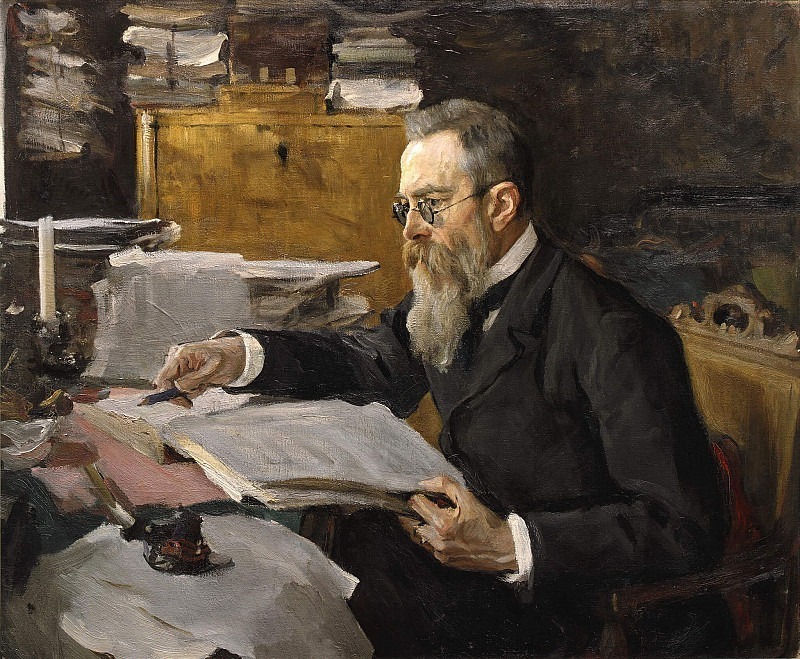Portrait of the composer N.A. Rimsky-Korsakov (1844-1908) Valentin Serov (1865-1911)
Valentin Serov – Portrait of the composer N.A. Rimsky-Korsakov (1844-1908)
Edit attribution
Download full size: 2048×1685 px (0,5 Mb)
Painter: Valentin Serov
Location: The State Tretyakov Gallery, Moscow (Государственная Третьяковская галерея).
The acclaimed master of portraiture, V. A. A. Serov was entrusted in 1898 to paint himself by a prominent composer, Rimsky-Korsakov. The artist always took on new work with particular trepidation. His models - not only familiar family and friends, but also a large number of people famous, mysterious, unattainable distant to the first meeting in the art studio. Connoisseurs of Serov’s work recognized this peculiarity of the gifted portraitist: he painted a genuine human character on canvas without any embellishment.
Description of Valentin Serov’s painting "Portrait of Rimsky-Korsakov".
The acclaimed master of portraiture, V. A. A. Serov was entrusted in 1898 to paint himself by a prominent composer, Rimsky-Korsakov. The artist always took on new work with particular trepidation. His models - not only familiar family and friends, but also a large number of people famous, mysterious, unattainable distant to the first meeting in the art studio.
Connoisseurs of Serov’s work recognized this peculiarity of the gifted portraitist: he painted a genuine human character on canvas without any embellishment. So sometimes it was scary to pose for the artist, because the portrait would reveal all the hidden features and the excitement of the soul, the whole inner life.
Like a willingness to confess was the decision to become a model for Valentin Serov paintings. In this magnificent property and expresses his genius. Therefore, still the number of those wishing to obtain a pictorial representation of his own nature did not decrease.
"Portrait of Rimsky-Korsakov" is a medium-sized canvas, the technique of execution is remotely reminiscent of the impressionist style. The color scheme is muted. The number of light areas on the canvas is four times less than the number of dark areas covered with chaotic rough strokes.
The dark brown of the furniture, the dirty green of the wallpaper, the dark gray of the austere jacket on the figure of the man sitting at the table of a respectable age... And only the bulky stacks of sheets spread out on the table and drawer shine with white light.
Across from the table you can guess the presence of a window, not included in the composition of the picture. The midday light is devoid of the sun’s yellow glare. The weather outside the window is rather overcast, anxious. The composer is serious, thoughtful, concentrated on his work. He holds an open manuscript with his left hand and his right hand aims to make additions to the work.
The posture of the slender man is straight and collected, the intelligent face is spiritualized. The features and facial expressions describe Rimsky-Korsakov’s character - strong-willed, confident and hardworking.
Кому понравилось
Пожалуйста, подождите
На эту операцию может потребоваться несколько секунд.
Информация появится в новом окне,
если открытие новых окон не запрещено в настройках вашего браузера.
You need to login
Для работы с коллекциями – пожалуйста, войдите в аккаунт (open in new window).




















You cannot comment Why?
The background of the painting is rich with details that suggest a study or private office. Piles of books and papers are visible, indicating a scholarly and intellectual environment. A lit candle stands on the desk, casting a warm glow and possibly symbolizing inspiration or late-night work. The overall atmosphere is one of quiet concentration and dedication to his craft.
The subtext of the painting likely highlights Rimsky-Korsakovs status as a respected composer and intellectual. The portrayal emphasizes his thoughtful and studious nature, hinting at the depth and complexity of his musical compositions. The surrounding environment of books and manuscripts serves as a visual testament to his prolific output and his deep engagement with music theory and composition. The pose, with him pointing at a page, suggests active engagement with his work, perhaps reviewing his own compositions or studying scores by others.